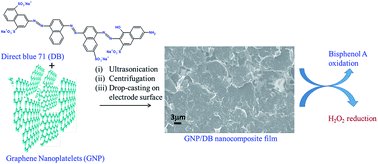Azo dye functionalized graphene nanoplatelets for selective detection of bisphenol A and hydrogen peroxide†
Abstract
Graphene nanoplatelets (GNP) have emerged as promising electrode material for electrochemical sensing applications because of their high conductivity, large surface-to-volume ratio, biocompatibility, and low cost. However, GNP are not soluble in water. We dispersed GNP in water with the assistance of a tri-azo dye, Direct Blue 71 (DB). Thin films prepared with GNP/DB dispersions were characterized by scanning electron microscopy (SEM), Raman spectroscopy, and UV-vis spectroscopy, which indicated the binding of DB with GNP films. A GNP/DB film coated glassy carbon electrode (GCE) exhibited high electrocatalytic activity to oxidation of bisphenol A (BPA) and reduction of hydrogen peroxide (H2O2). The GNP/DB film greatly enhanced the BPA oxidation peak current at +524 mV, and the H2O2 reduction peak current at −400 mV vs. Ag/AgCl in pH 7.0 phosphate-buffered saline (PBS) solution. The oxidation peak current was proportional to the BPA concentration from 10 nM to 100 nM and 100 nM to 25 μM, with a limit of detection of 1.23 nM. The GNP/DB-modified GCE also showed a remarkable decrease of over-potential for the reduction of H2O2 with a fast amperometric response of less than 2 s, a good linear range of 10 μM to 1.9 mM, and a high sensitivity of 57.6 μA mM−1. The fabricated sensor shows good reproducibility and stability with limited interference. Furthermore, the sensor was successfully applied to determine BPA in spiked commercial milk and juice samples.



 Please wait while we load your content...
Please wait while we load your content...